5 free timesheet templates for accurate time tracking in 2026

Timesheets are a tried-and-true method for tracking employee work hours. While not necessary for every business model, they can be essential for distributing tasks fairly, avoiding burnout, and ensuring accurate payroll and compliance — particularly in roles or industries where time tracking directly impacts operations or billing.
To help you get started with time tracking (or improve this core process across your company), we’ve created five free, customizable timesheet templates. Whether your payroll cycle runs biweekly or monthly, or you need project-based, weekly, or daily tracking, we’ve got a template for you. We also touch on more efficient, automated time-tracking solutions.
💜 Leapsome helps track hours with ease
Templates are great. But precise, automated time tracking is even better. Get your hours right every time with Leapsome’s HRIS.
👉 Learn more
1. Daily timesheet template
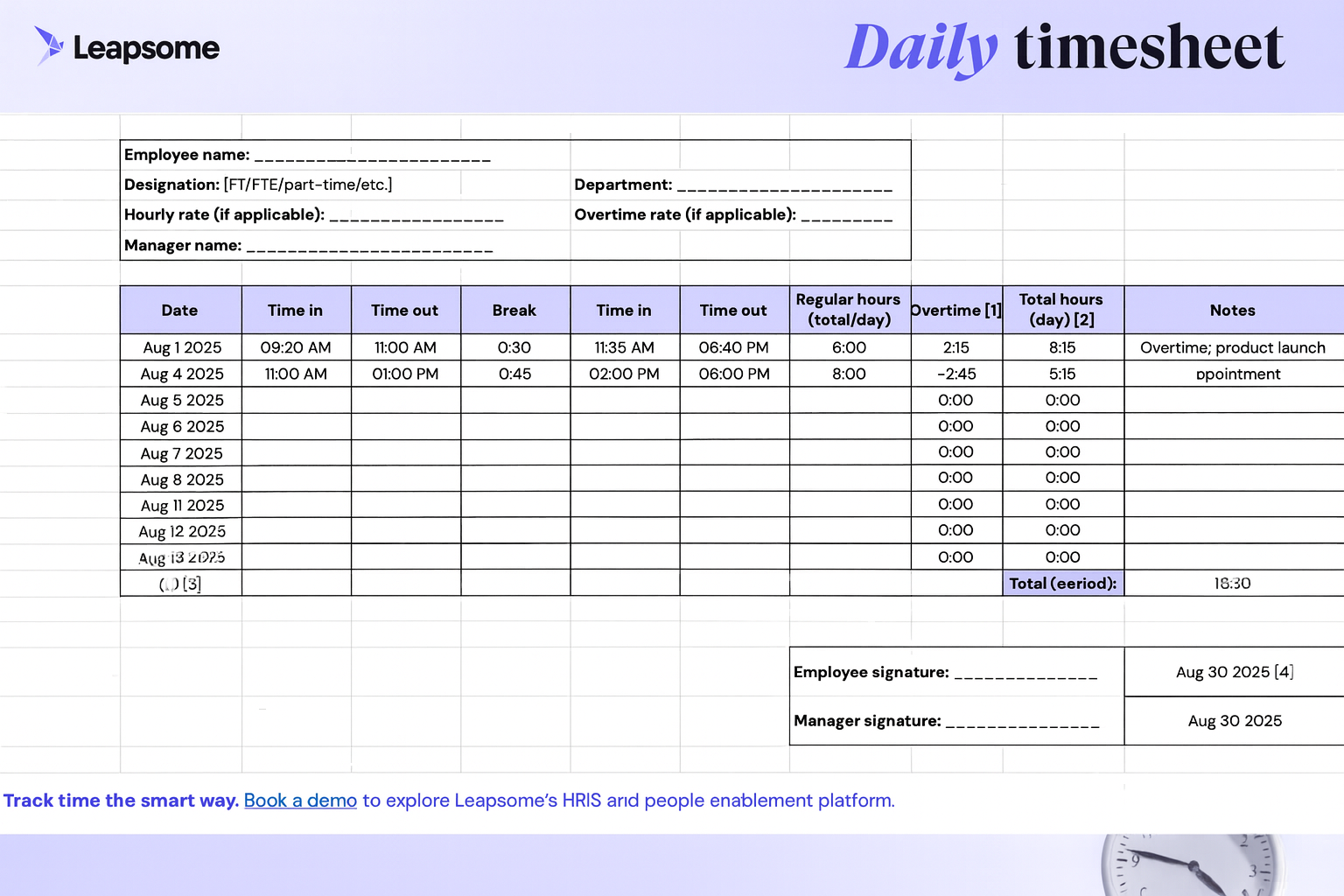
About daily timesheet templates
Daily timesheets help you keep track of hours worked on a daily basis. This template provides ample space for recording billable hours vs. overtime hours. There’s also space for note-taking and extra information related to hours worked and billing type, which will make audits smoother if they arise.
When to use a daily timesheet template
Daily timesheets are a great option for businesses looking to get hyper-granular with their time tracking. That’s why they’re often used for freelancers, contractors, and employees who record their activities by the hour.
⏰ Download the free daily timesheet template here.
2. Weekly timesheet template
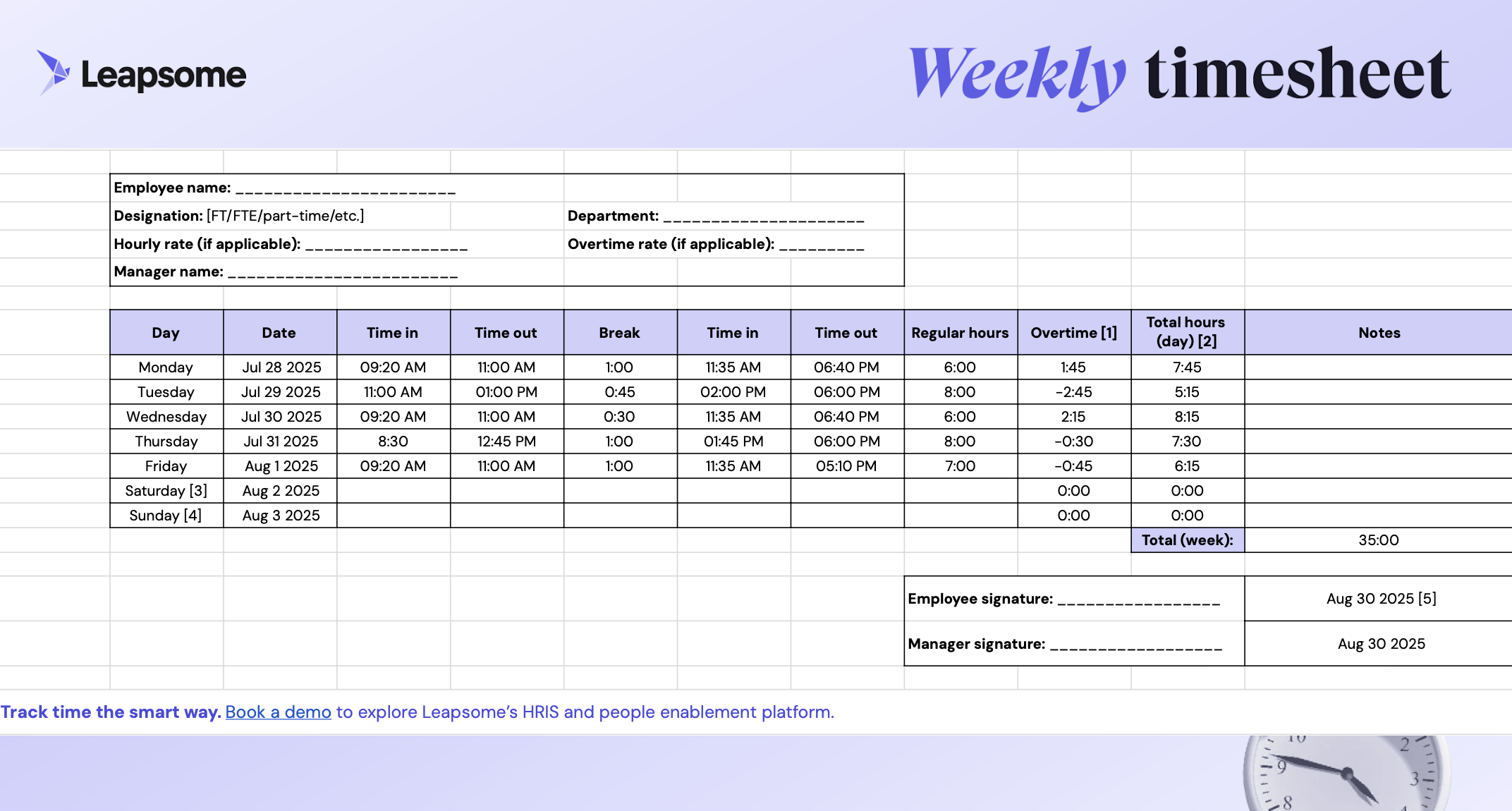
About weekly timesheets
Weekly timesheets record hours worked each week. They provide some granularity but are easier to maintain than daily timesheets, as they require less frequent note-taking and administration.
When to use weekly timesheets
Weekly timesheets work well for organizations where employees have regular weekly shifts or hours. They’re also popular for businesses that work with a weekly pay cycle or simply don’t need the granular detail or hassle of daily timesheets.
⏰ Download the free weekly timesheet template here.
3. Biweekly timesheet template
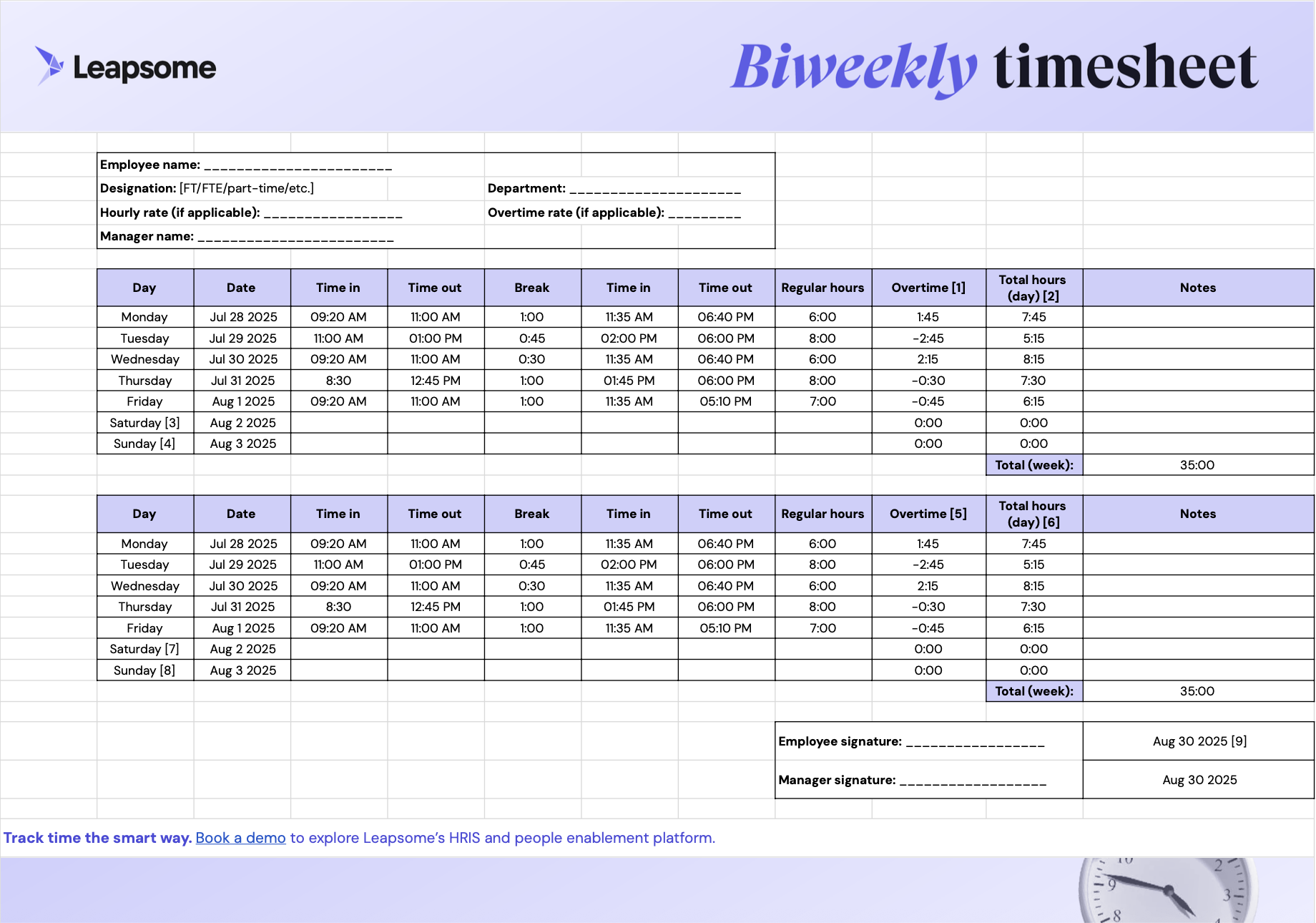
About biweekly timesheets
Biweekly timesheets track hours worked on a biweekly basis, or every two weeks. They’re a good compromise between granularity and time efficiency and are popular as they sync with biweekly payroll cycles.
When to use biweekly timesheets
Biweekly pay is the most common payroll schedule in the United States, with 43% of private establishments paying employees every two weeks, according to the Bureau of Labor Statistics. Organizations with a biweekly payroll typically align their timesheet practices accordingly.
⏰ Download the free biweekly timesheet template here
4. Monthly timesheet template
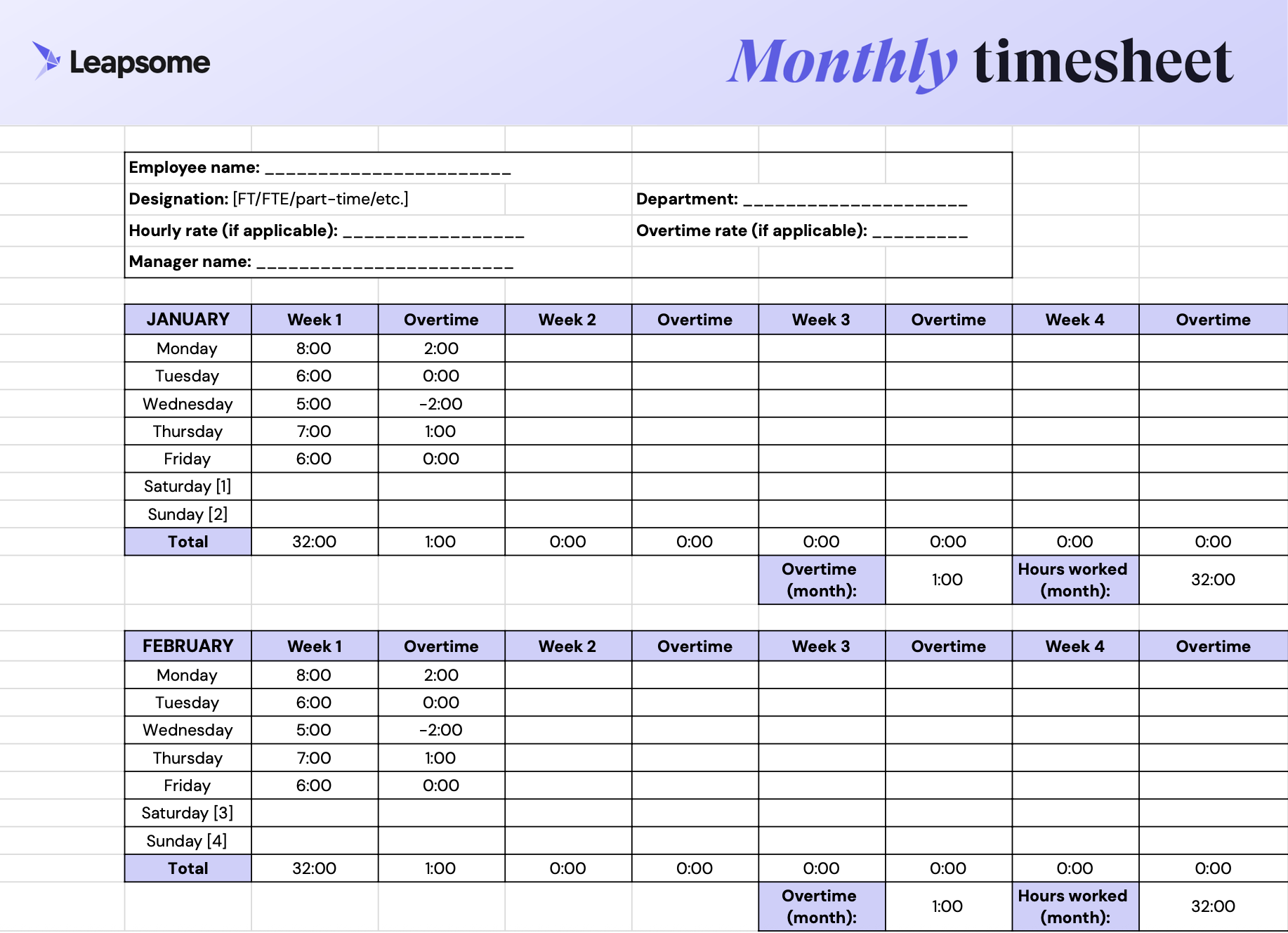
About monthly timesheets
Monthly timesheets allow you to record hours worked per month. They’re popular with organizations that pay employees monthly as they streamline admin, paperwork, and payroll preparation.
When to use monthly timesheets
Monthly timesheets are ideal for companies with salaried employees who work standard hours and use a monthly payroll cycle, which is particularly common in Europe.
⏰ Download the free monthly timesheet template here
5. Project-based timesheet template
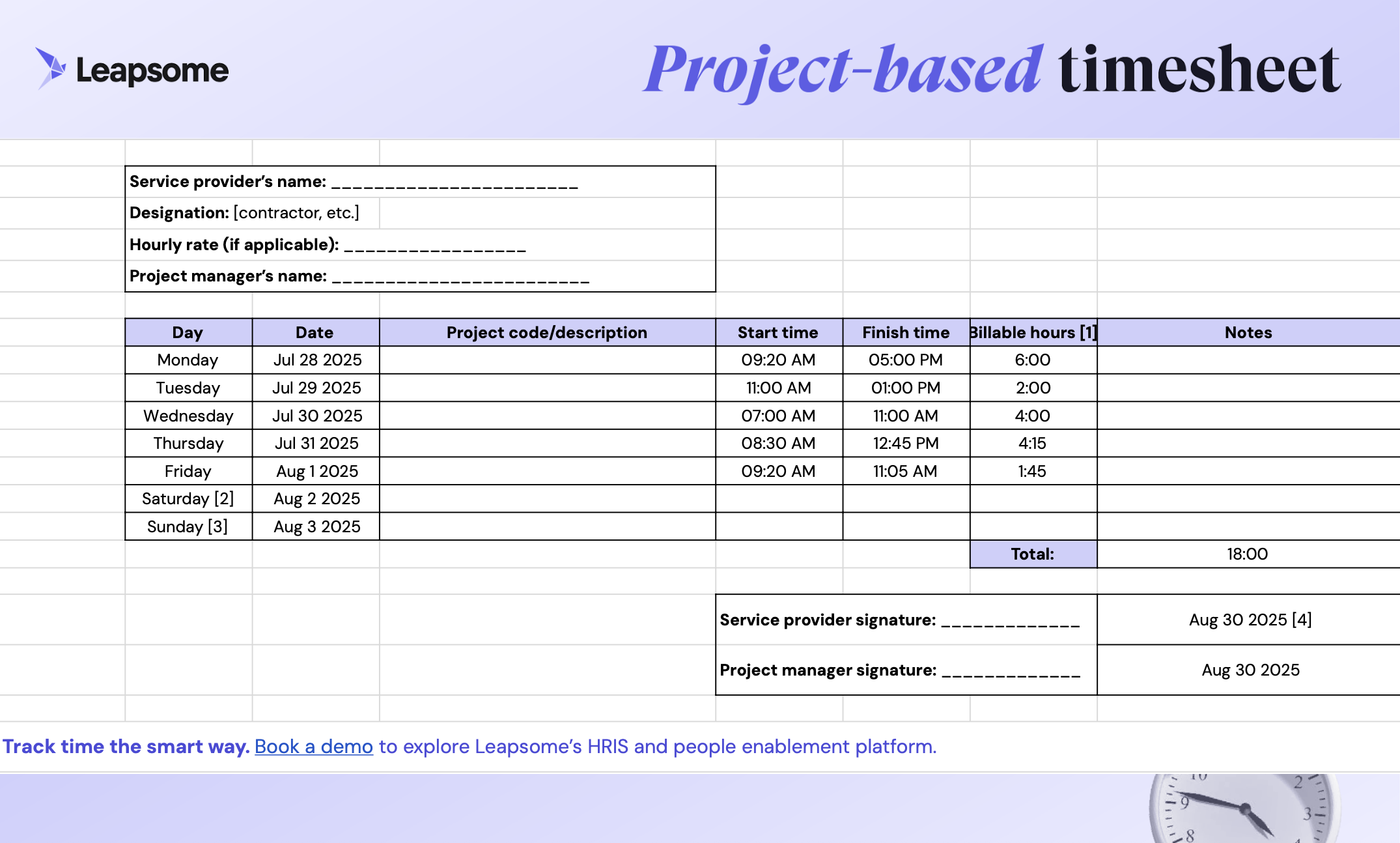
About project-based timesheet templates
Project-based timesheet templates record employee hours based on the time they spend on different clients and projects. Our template provides space to document the nature of the project, so you can get context on the different activities and tasks.
When to use project-based timesheet templates
Project-based timesheet templates are useful for freelancers and contractors, as well as agencies and consultancies that work with various clients and need to understand project-based hours for accurate billing and capacity planning.
⏰ Download the free project-based timesheet template here
Potential drawbacks of using timesheet templates
While timesheet templates are an effective way to track employee time, they have significant limitations. Manual timesheets — whether in Excel, Google Sheets, or a printable format — are prone to human error. A missed keystroke or incorrect formula can easily throw off payroll, project budgets, and productivity insights.
Relying on manual data entry also slows your team down. Employees spend valuable time updating spreadsheets, and managers often have to chase down missing information. Plus, once the data is in, it’s tough to extract meaningful insights. Sorting through rows of time entries to spot trends, optimize workload distribution, or check compliance becomes a tedious, time-consuming process.
A good time-tracking app can solve all of these issues. The best time-tracking software solutions offer smart automations, real-time visibility, and seamless integrations, taking the guesswork out of iterating your time-tracking process.

There are several dedicated time-tracking platforms like Toggl Track and TimeCamp, but if you’re looking to centralize and supercharge your organization’s time-tracking approach, consider a solution that’s embedded in a human resources information system (HRIS) like Leapsome.
Because Leapsome’s HRIS hosts all of your employee data, you can centralize your HR function and take care of all your core HR tasks in one place. Plus, the same platform can support people enablement and engagement initiatives.
😎 Track time like a pro with Leapsome
Plus, unlock an award-winning suite of HR and people enablement capabilities that empower employees to do their best work.
👉 Book a demo
Frequently asked questions about timesheet templates
What is a timesheet template?
A timesheet template is a formatted document that allows employees and HR professionals to record hours worked over a period or on a specific project. A thorough template should include fields for the date, start and end times, breaks, total hours worked, notes, and sometimes project or task details.
Timesheet templates are a good option if you’re getting started with time tracking. They help you manage attendance, calculate payroll, monitor productivity, and support compliance with labor laws. But they also require lots of manual data entry, which can make it challenging to reap all of the benefits of time tracking, so time-tracking software is a better option for many organizations.
Verwandte Artikel
Zurück zum BlogSind Sie bereit, Ihre Strategie zur Mitarbeiterförderung zu verbessern?
your People operations?
Informieren Sie sich über unsere Leistungsbeurteilungen, Ziele und OKRs, Engagement-Umfragen, Onboarding und mehr.
.webp)
.webp)
 Fordern Sie noch heute eine Demo an
Fordern Sie noch heute eine Demo an





.png)

.jpg)























